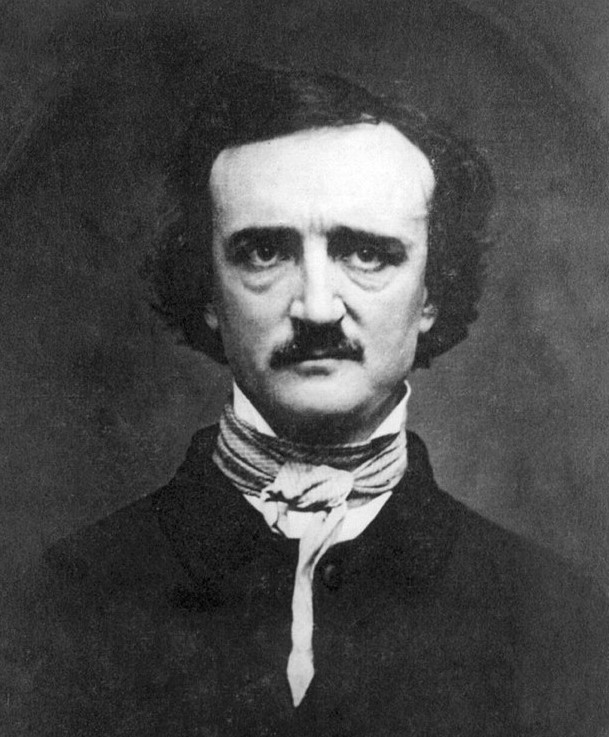Introduction to Edgar Allan Poe by Sidney Torres Salazar
Edgar Allan Poe (1809–1849)
by Sidney Torres Salazar
Edgar Allen Poe, one of America’s most renowned authors, has left an inedible mark on literature through his mastery of Gothic fiction, psychological horror, and the creation of modern detective stories. His works explore themes of death, madness, love and the supernatural, often mirroring the tragic experiences of his own life.

Born on January 19, 1809, in Boston, Massachusetts, Edgar Allan Poe’s life was marked by tragedy from the start. His parents, both actors, die before he turned three, leaving him an orphan. Poe was taken in by John and Frances Allan, a wealthy couple from Richmond, Virginia, though John Allan’s reluctance to fully support Poe created lifelong tension. Poe’s early life was marked by instability and conflict, both financial and personal. Poe attended the University of Virginia but dropped out due to bad habits such as gambling debts, straining his already fragile relationship with his foster father. He later enlisted in the military and briefly attended West Point but was discharged after deliberately neglecting his duties. His literary career began during this critical period, with his first volume of poetry, Tamerlane and Other Poems, published in 1827. Financial struggles plagued Poe through his life, and he often worked as an editor to support his writing. In 1836, Poe married his 13-year-old cousin, Virginia Clemm, a union that has been the subject of much scrutiny. Their marriage was both a source of inspiration and sorrow for Poe, particularly when Virginia’s health began to decline. Her death in 1847 profoundly affected him, and his subsequent decent into alcoholism and depression further destabilized his life. Poe himself dies under mysterious circumstances in 1849, leaving behind a legacy of innovation and literary genius.
Edgar Allan Poe wrote during the early to mid-19th century, a period characterized by significant culture and literary developments in America. Romanticism, with its emphasis on emotion, individualism, and the sublime, heavily influenced his work. Poe’s dark, brooding stories diverged from the optimistic ethos of transcendentalist contemporaries like Ralph Waldo Emerson, marking his as a unique voice in American literature. The rise of Gothic fiction in Europe also shaped Poe’s style. Authors like Mary Shelley and Ann Radcliffe explored themes of the supernatural, decay, and human fallibility, proving a foundation for Poe’s literary experiments. However, Poe added a distinctly psychological dimension to the Gothic tradition, emerging into the minds of his
characters and exploring themes of obsession, madness, and guilt. Poe’s role in the development of the short story Is another historical milestone. At a time when novels dominated the literary scene, Poe championed the story as a legitimate art form. His essays, particularly “The Philosophy of Composition,” articulated his belief in the “unity of effect,” emphasizing the importance of every detail contributing to a story’s emotional impact. This approach revolutionized storytelling and solidified Poe’s place in literacy history. Poe’s works are rich with symbolism, psychological depth, and technical precision. Two of his most famous works, “The Raven” and “The Tell-tale Heart,” illustrate his mastery of these elements.
In “The Raven,” Poe creates a haunting exploration of grief and loss. The poem’s melancholic tone, established through its musical rhythm and dark imagery, immerses readers in the narrator’s despair. The raven, a symbol of unrelenting memory and death, becomes an external manifestation of the narrator’s inner torment. The repetition of “Nevermore” reinforces the inevitability of loss, resonating with universal themes of mourning and existential dread. “The Tell-Tale Heart,” on the other hand, delves into the psyche of its unreliable narrator. The story explores themes of guilt and paranoia as the narrator obsessively insists on his sanity while recounting the murder of an old man. Poe’s use of first-person narration draws readers into narrator’s disturbed mind, while the rhythmic repetition of sound, the beating of the old man’s heart-heightens the story’s suspense. The climax, in which the narrator
confesses to the crimes underscores the power of guilt to unravel even the most calculated plans. Beyond these famous works, Poe’s detective stories, such as “The Murders in the Rue Morgue,” deserve recognition for their influence on modern crime fiction. Poe introduced the archetype of the brilliant detective and emphasized logical deduction, inspiring author like Arthur Conon Doyle and Agatha Christie. The two selections in this anthology, “The Black Cat” and “The Purloined Letter” allow readers to experience similar themes and literary approaches.
Edgar Allan Poe’s contributions to literature extend far beyond his lifetime. He is often regarded as the father of detective fiction, and his focus on psychological complexity laid the groundwork for modern psychological thrillers. His works have influenced countless writers, from H.P. Lovecraft to Stephen King, and his themes continue to resonate in contemporary literature and film. Socially and culturally, Poe’s exploration of the macabre and the uncanny challenged 19th-century norms. His works often examined taboo subject, such as death and insanity, forcing readers to confront the darker aspect of the human experience. This willingness to explore the grotesque and the unknown contributed to his enduring appeal. Poe’s legacy is also evident in popular culture, where his imagery and themes have been adapted into films, music, and art. His influence on genres like horror and Gothic fiction remains unparalleled, and his works continue to captivate audiences worldwide.
Source: Text included with the permission of the author.
Image Credit: “Edgar Allan Poe,” Grace Hammond, Virginia Western Community College, derivative image from “Edgar Allan Poe,” W.S. Hartshorn, Wikimedia, Public Domain.

